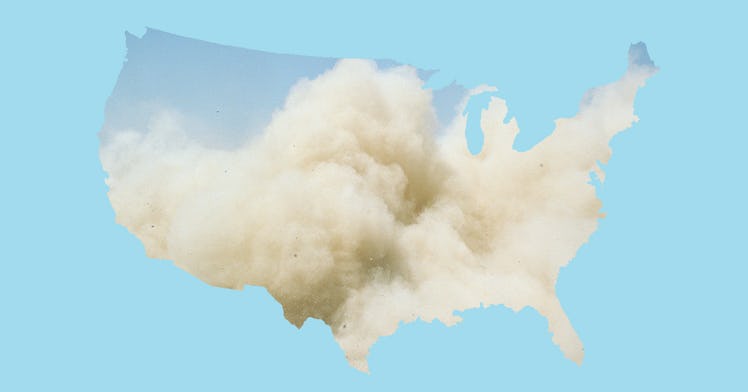7 Things Families Need to Know About the Dust Cloud
A dust cloud is coming for the United States. No, it's not apocalyptic. Here's what you need to know.

News reports have been positively swirling about a massive dust cloud — otherwise known as a Saharan Desert dust plume — that has been originating from the Saharan desert and is making its way across a 5,000 mile stretch of the Atlantic and hitting parts of the southeastern United States later this week. But what do families need to know? Is the desert plume unusual? Will it affect our health? Is there anything good about it? Here are the 8 things that families need to know about the Saharan dust cloud — and what it means for them.
1. Dust clouds happen every year.
Every single year, a dust cloud originates from the Saharan desert and makes its way across the Atlantic. They’re a common summer occurrence, sometimes happening several times in a summer season, and move across the North Atlantic every three to five days during the northern hemisphere’s late spring to early autumn. The Saharan Air Layer (SAL) as meteorologists refer to it is a normal part of the season. The dust moves along with the trade winds, winds that move east-to-west and pick up the strongest during the summer time. The dust bombs typically stay intact and diffuse over the Caribbean. But that doesn’t appear to be the case with this dust plume.
2. This dust plume is unusually large.
Part of the buzz around this year’s dust cloud is that the current cloud barreling towards the United States is unusually large. Some suggest it’s the thickest dust cloud in decades to reach the Caribbean — and the hazy skies that have hit the islands in that area are proof positive.
That might mean that the dust cloud that hits the United States will be far more intense than usual, and that health effects due to the cloud might be more severe. The cloud has yet to disintegrate over the Caribbean sea, as you can see by the low visibility in the islands, while visibility in Trinidad and Tobago is limited to half a mile.
3. Even though it’s huge, most of it will probably stay in the atmosphere.
The unusually large dust cloud will eventually hit the southeastern area of the United States, but don’t expect to breathing in too much particulate matter. The dust plumes generally stay at least 5,000 to 20,000 feet in the air — making for beautiful sunsets and hazy skies, but it’s not like a haboob or anything.
4. Yes, the dust plume is coming to the United States this week.
Experts and meteorologists say that while the thickest parts of the dust layer will stay south of Florida this week and hover over Cuba, by the end of this week, Texas and much of the southeast region of the country will be covered. The dust will, per above, be atmospheric — the biggest inconvenience many will face will likely be that cars and windows will be dirty. But for those with lung problems, the dust could be a major issue.
5. There will be side effects for those who have underlying upper respiratory issues.
For the most part, these dust plumes won’t be anything but slightly annoying and cause some beautiful sunsets. But for those who have asthma, allergies, or upper respiratory illnesses (yay, COVID!) the dust plumes can aggravate symptoms and make the next few weeks a seriously painful experience. Experts suggest limiting time outside if you suffer from any of these issues in order to limit aggravation, wearing masks, closing your windows, and using air cleaner.
6. It might kill hurricanes.
There is some good news about the dust plume — it acts as a barrier against hurricanes and hurricane season. The dust, which dries out the atmosphere, makes it difficult for humid, wet, hurricane like conditions to form. That’s good news for what is supposed to be an especially violent hurricane season.
7. Go check out those sunsets.
Perhaps one of the few pluses is that for the next week or so, the sunsets will be incredible. So, if you can do so healthily, go check out those sunsets in your backyard and have a beer while enjoying a totally normal (if a little extreme) natural occurrence.